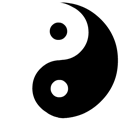
Chinese Philosophy and Esoteric Science
Lessons from Tao Te Ching.
By Sandra Jones Wu
From lectures given by Dr. Fred M.A. Wu
Tao is the “way,” “principle” or “reason.” But none of these names really define it. Tao is like but unlike God. “It gives life yet claims no possession; it benefits them yet exacts no gratitude; it is the steward yet exercises no authority.” It does not demand obedience, so the Taoist is free.
Te is “virtue” or “truth.” Ching means “book.” Tao Te Ching can be translated as Truth and Nature. Lao Tzu, its author, believed that a person of many talents should do his or her best in one field, and then move on to another field. As he was leaving his home district, Lao Tzu was asked by the gatekeeper to stay and teach the people. Lao Tzu was allowed to leave only after writing the Tao Te Ching, a work of only 5,000 Chinese characters. The three branches of Taoism are philosophy, religion and esoteric science. Taoism philosophy and esoteric science constitute the foundations of Chinese medicine and martial arts.
Tai chi means “one.” It comes from wu chi, emptiness. [Tai chi tu] The principle of yin and yang is the essence of Tai chi. Yin is yielding, soft, feminine. Yang is powerful, masculine, positive. The Tai chi symbol (Tai chi tu) symbolizes yin and yang flowing into one another; where one stops, the other begins. The symbol is a circle, denoting power. The line between yin and yang is S-shaped, symbolizing energy, and called one-chi. One gives birth to two, two gives birth to three, three gives birth to 10,000 things. One is Tai chi, two is yin and yang, three is one-chi. From this all things come.
Taoism has two “theme songs” – quietism and inaction. Inaction is often misunderstood as “do nothing.” It implies that one must do everything to think about a problem before jumping to a conclusion or taking action. Nature constantly acts, but reveals itself so slowly that it seems like nonaction. In order to learn inaction, one must have quietism…developed through calmness, deep thinking and meditation. Through quietism, one may tap into “prenatal knowledge” to help solve problems in this life.
Taoism follows the Laws of Nature: Law of Cycles, Law of Gentleness, Law of Continuity, Law of Rhythm
The Law of Cycles has three components:
- Law of Polarity, or yin and yang, north and south, day and night, etc.
- Law of Periodicity, or recurrence, illustrated as a cosine curve. Our lives are always up and down, the seasons always follow one after the other.
- Law of Reversion to the Opposite. After pushing to the maximum, one reverts to the opposite extreme.
The Law of Gentleness can be divided into three phenomena:
- Gentleness survives better than hardness. A willow tree bends when loaded down with snow and ice, but the limb of an old oak tree breaks. Women live longer than men.
- Gentleness can win over hardness. Gently dripping water can eventually wear a hole or create a cave in hard limestone rock.
- Gentleness is the mother of speed and power. This concept describes the internal system of martial arts development. Compare the power and speed of the strike of a long staff to that of a whip.
The Law of Continuity means that the universe goes on and on and never stops. In our lives, it means that patience, persistence, self-discipline and restraint are necessary to have good results at our endeavors.
The Law of Rhythm.
Followers of Taoism believe that if you follow the Laws of Nature, you will have harmony with yourself, with others and with nature. You will then have “heaven on earth:” Happiness, Health and Longevity.